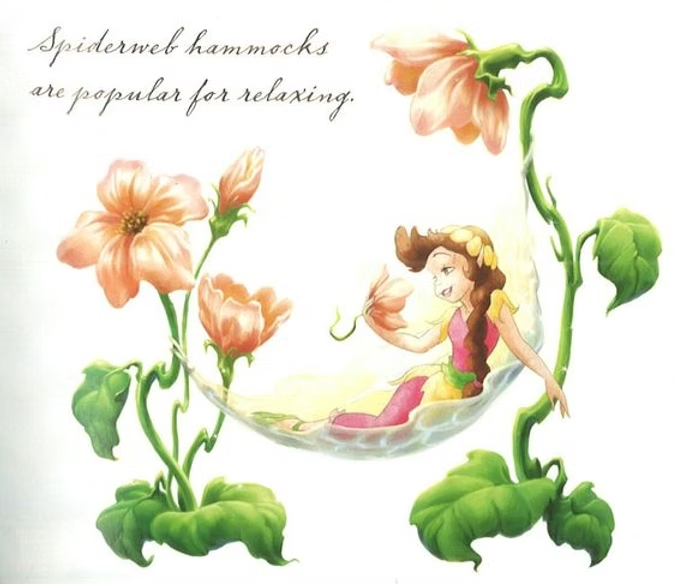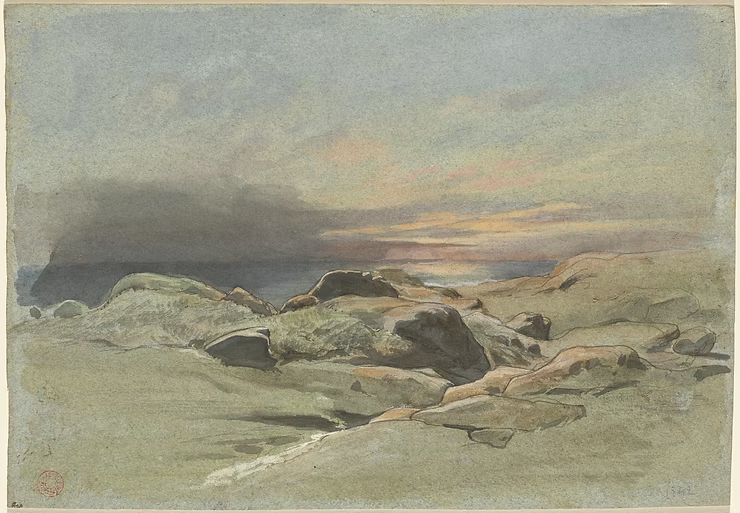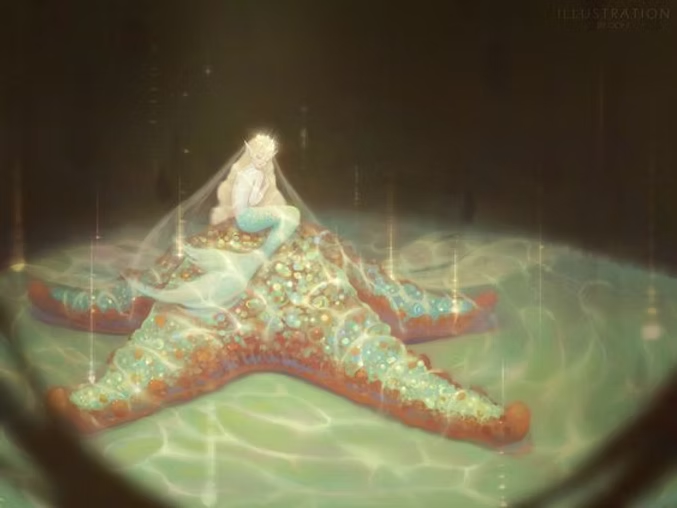Draped in Petals: How Nature Inspires Fashion from Pixie Hollow to Dior
I enjoyed a childhood just in time to experience DVDs at their height. “Streaming” wouldn’t enter the common vernacular until I was a pre-teen. So my younger years were full of rewatching the same movies and shows as many times as my portable DVD player could handle. The beauty of this now-defunct tech, beyond the irrevocability of the media itself, was access to Bonus Features. I watched most of my favorite movies’ Bonus Features as often as I watched the films themselves.






In a “guide to Pixie Hollow” type book, the author and illustrator explained to readers how the residents of Pixie Hollow made their homes, furniture, and clothing out of the resources available to them. See below, a spiderweb hammock.

To this day I imagine flippy skirts when I see a rose, or avant-garde gowns when I look at an orchid at the right angle. There is magic in bypassing scale, breathing in the beauty, and trying to bring natural elements into functional design. Flora and fauna are my favorite points of inspiration, particularly in fashion and architecture- something which some well-celebrated designers share!
One of the few male fashion designers that I believe truly recognized women and femininity was Christian Dior. He launched his fashion house with a collection titled Corolle in 1947, which is literally the botanical term for the petals of a flower. The essence of this collection was clear, and remained clear throughout much of his work. His careful design made his gowns ethereal and a true homage to the delicacy and organic nature of femininity. Dior seemed to recognize the strength and obviousness with which women are linked to nature. His muses and his creations were one and the same, echoing the cyclical quality of a life, of a flower, of our existence. These gowns are breathtaking on their own, but do something magical when paired with a woman. This, I think, is the ultimate test in fashion.






Iridescence is one of those qualities that nature does so well and is so ephemeral that humans struggle to capture it. Artists and photographers able to do it justice are my heroes on Earth. This is one of my favorite color palettes and aesthetic details- if you check out my Pinterest– it’s overflowing with it. There is something so calming and grounding that this kind of softness brings over me. If I could just climb into this set of 6 pictures and live there forever, I would. The relationship between light and texture that produces this ~vibe~ is so inspiring, in my opinion. It can make materials such as oyster shells, look soft to the touch, and give depth and dimension to something as fleeting as a bubble or the wing of a butterfly.
Something I find curious is how the best human-made mimics of these natural colors, textures, and qualities are made with the most polyester, synthetic materials in circulation. In the photo set below, see the top left, bottom middle, and bottom right below for great examples of how fabric can emulate the iridescence found in bubbles, pearls, butterflies and water. The reflective quality is more easily achieved with what’s basically plastic, than any natural material.
A principle that designers use to add an organic element to fabric is the use of gradient. As seen in the images below, there is a kind of gradation at play, providing a quality that evokes growing or evolving. One dress uses carefully placed purple beads in decreasing density and saturation to produce an effect as though the beads are dissolving from the seams into the white fabric. Another dress uses both color gradient and a sewing technique that I want to call a lettuce hem (but I could be wrong, I’m not an expert) to achieve a gravity-defying, jellyfish-like finish. Another uses a simple color gradient: gradually changing a color from a starting point to an ending point with many small increments of saturation or hue. The reason I think these techniques evoke an organic feel in the design is that stark color contrast, while definitely present, is less common in nature than some kind of gradient. Leaves and petals taper off into points, fruits and vegetables seamlessly blend multiple colors (consider the inside of a watermelon or an heirloom tomato, just for example), and sunsets do this so well it’s impossible to tell where the purple ends and the blue or pink begin.






A designer I’ve had my eye on is Jasmin Larian Hekmat, the mastermind behind Cult Gaia. Her legacy doesn’t just include incredible fashion design, you can thank her if you were ever a Bratz doll fan (Jasmin… Yasmin…!). She is the daughter of Isaac Larian, the toy industry titan who gave the green light on Bratz only after an 11 year-old Jasmin said they were “cute”.
Now, a titan in her own right, Jasmin runs the Cult Gaia brand, pictured below, with the modus operandi of “artful, effortless, and magic”. She points to the sun, its light, and its relationship with nature as her main inspiration. It’s like she took the words right out of my mouth. I’ve fallen in love with her work, primarily the pieces that look like they belong in the ocean. I love the way the bottom center dress looks like coral or anemone, the way the top left dress like it’s dripping with water, and the way the top left dress like a cast net left too long in the sea. Some of her work is more “ready to wear” in the sense that anyone would feel comfortable wearing her clothes. But I appreciate her dedication to keeping things a little weird and consistently pushing the boundary of what is considered “out there”.






My last spotlight falls on none other than the master herself: Iris Van Herpen. I’m not going to lie, I’m a little scared of her, but in the way that the shepherds were probably afraid of the angels in the bible. Her creations are truly extraordinary and blend natural inspiration with technology in a cool and, frankly, intense way. Her work is not for everyone, and I will be the first to admit that there is a lot of it that I don’t really like. I respect her deeply, as she has ventured into a signature that few other major labels dare touch. What she creates is eco-futuristic fashion that isn’t afraid of being grotesque, confusing, or unconventional. She plays with structure and shape to mimic aspects of her natural muses while playing with technology to bring her designs beyond replication and into innovation.






I created these two sets of photos (above and below) to demonstrate my gut reactions to seeing Iris Van Herpen’s work. Initially, I see future, technology, machine. Upon deeper reflection, I see the simple creatures that give us this beauty already. I think what Iris does is incredible, while giving me a small twinge of sadness. I suppose my nostalgia comes from knowing that technology is taking is to places we can’t even imagine, while most of us find ourselves in a place where truly appreciating and seeing much of nature up close isn’t a part of daily life. We coexist with technology and have dominion over it now (somewhat), but there is no telling how our futures will be impacted by it’s omnipresence long term.






With the advent of generative AI of the last few years and the ever accelerating pace of fashion cycles, what does the future of design hold? We’ve come a long way from 1940’s Dior. I wonder what he would say about Iris Van Herpen’s work, or that of any of her peers. It’s fascinating and impressive, of course. But my inclination is almost to grieve the inspiration that still lives on. The little bird or the moth that provided the spark for a new sewing technique, or application of technology- they’re still what they always were. I invite you to recognize the artistry that creatives continue to innovate, while still honoring the creatures that provide their inspiration.
Remember the willow tree, for it may seem dull after watching so many dazzling iterations of it spawn from our human desire to imitate, but its beauty and love remains, waiting for you to come home.
The images featured in this post are not owned by the author and are sourced from public websites and forums. All rights to these images are retained by their respective owners. The use of these images is intended solely for informational and entertainment purposes and is not for commercial gain.
The author does not receive any monetary compensation from the use of these images. If you are the rightful owner of any image and believe it has been used without proper authorization, please contact us immediately. Upon verification of ownership, we will promptly take action to credit or remove the image as requested.








